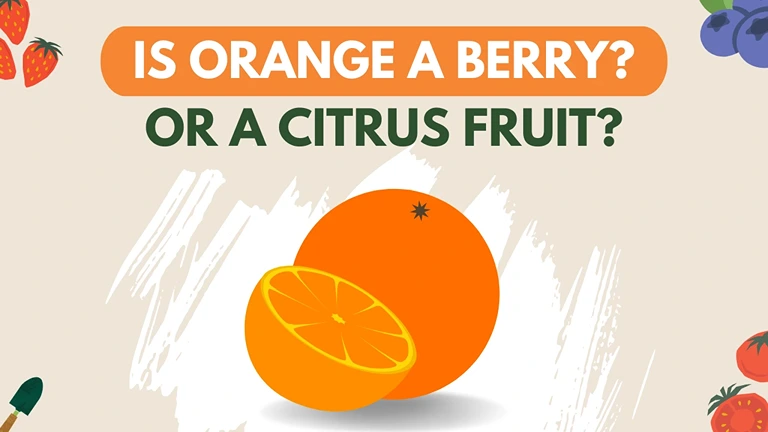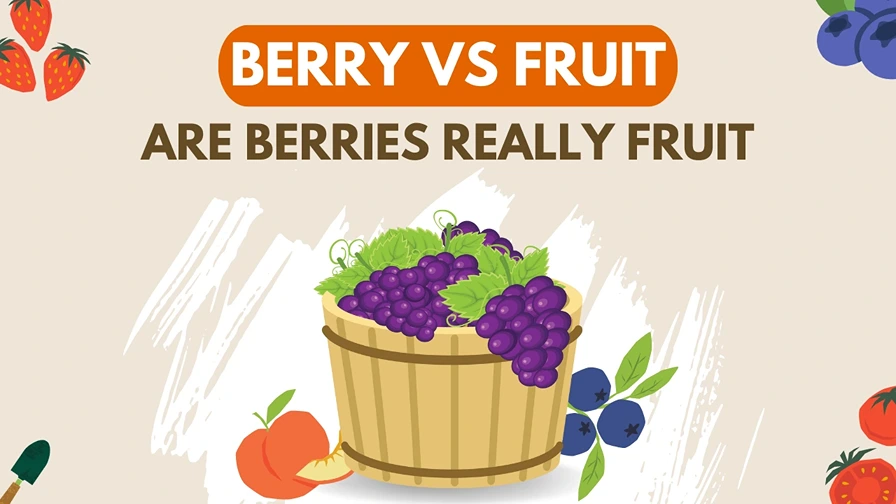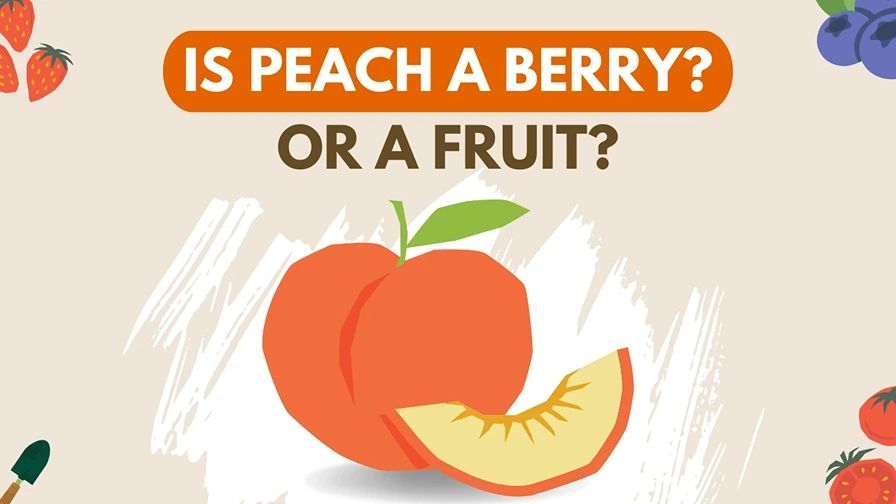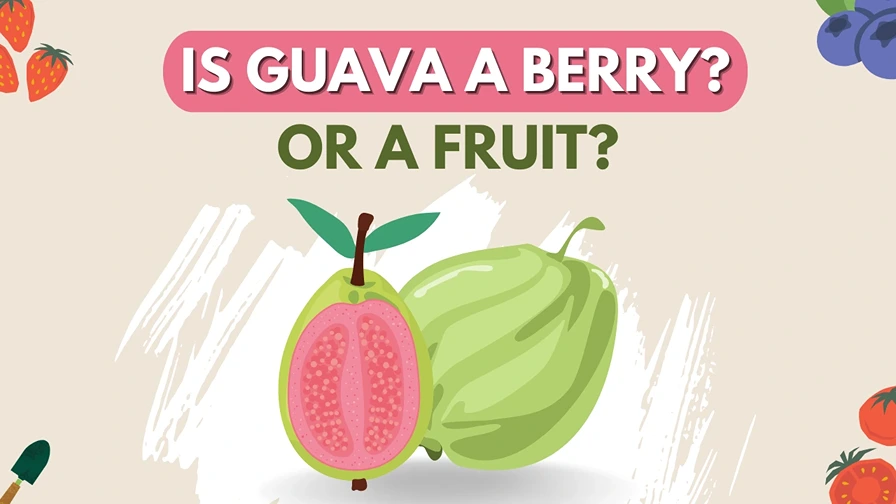When it comes to the classification of fruits, things can sometimes get a little confusing. Like oranges that often spark curiosity. Many people wonder whether: is orange a berry?
To answer it: Yes, orange is a type of berry. Orange is classified as citrus fruit also known as Hesperidium, which is a type of berry just like pepo fruit.
So why is orange classified as citrus fruit and not a true berry? Let’s explore this berry vs fruit debate!
What is an Orange?
Oranges are citrus fruits that belong to the Rutaceae family, which also includes other citrus varieties like lemons, limes, and grapefruits. They are well-known for their vibrant orange color, refreshing taste, and juicy flesh.
Oranges are round or oval in shape, with a leathery peel that encases the pulp. The pulp of orange is divided into segments, each filled with delicious, citrusy juice.
From the outside, oranges might not appear similar to the typical berries we envision, but their classification goes beyond mere appearances.
History and Origin of Oranges
Oranges have a long history that begins in ancient times. While their exact origin is uncertain, they are believed to have originated in Southeast Asia, particularly in China and India.
These regions were the first to cultivate and domesticate citrus fruits, including oranges.
The cultivation of oranges spread throughout the world due to trade and exploration. Arab traders played a significant role in introducing oranges to the Mediterranean region, while European explorers brought them to the Americas.
Oranges thrived in the favorable climates of these new regions, leading to the establishment of extensive orange orchards.
Over time, advancements in transportation and agricultural practices allowed for the global trade of oranges. This made oranges widely accessible and popular across different cultures.
Through selective breeding and grafting techniques, various orange varieties were developed, each with its own unique characteristics.
Today, oranges are enjoyed worldwide for their refreshing taste and nutritional benefits. They have become an integral part of culinary traditions and are cherished for their vibrant color and juiciness. The rich history and global presence of oranges have made them a beloved fruit that continues to be cherished by people of all ages.
Botanical Classification of Orange
- Family and Genus: Oranges belong to the Rutaceae family, which is commonly known as the rue or citrus family. Within this family, they are classified under the genus Citrus.
- Species and Hybrids: The scientific name for oranges is Citrus × sinensis. The “×” symbol represents that oranges are hybrids, resulting from the crossbreeding of two citrus species: pomelo (Citrus maxima) and mandarin (Citrus reticulata). This hybridization gives oranges their unique characteristics.
- Varieties of Oranges: Oranges have numerous varieties, each with its own distinct traits, flavors, and uses. Some popular varieties include Navel orange, Valencia orange, Blood orange, and Seville orange.
Is Orange a Berry?
In the world of botany, a berry is a type of fruit that develops from the ovary of a single flower, typically containing multiple seeds. Unlike other fruits, berries have a fleshy pericarp, which refers to the thickened wall of the fruit surrounding the seeds.
One distinctive feature of berries is their seed placement. The seeds are embedded within the flesh of the fruit itself, as opposed to being housed in a separate core or compartment.
This internal arrangement sets berries apart from fruits like apples or cherries, where the seeds are contained within a central core or pit.
Now that we understand the botanical classification of berries, let’s see if orange aligns with the berry classification or if there is a difference.
Similarities of Oranges With Berries
While oranges may not resemble a traditional berry in appearance, they do possess several characteristics that align with the berry classification.
Let’s explore some of the berry-like traits exhibited by oranges:
- Fleshy Pericarp: Like berries, oranges have a fleshy pericarp, which refers to the thickened wall of the fruit surrounding the seeds. This feature is a key criterion for classifying fruits as berries.
- Multiple Seeds: Oranges typically contain multiple seeds embedded within the flesh, another characteristic shared with berries. These seeds are dispersed throughout the fruit, rather than being concentrated in a central core or pit.
- Juicy Pulp: Oranges have succulent and juicy pulp, much like the flesh of berries. The refreshing juice within an orange’s segments contributes to its berry-like qualities.
Differences from Typical Berries
Oranges share some berry-like characteristics as we discussed above, but they also possess distinctive features that set them apart from typical berries.
Here are some ways in which oranges differ from traditional berries:
1. Pericarp Structure: Hesperidium fruits, including oranges, have a thick and leathery outer peel called the exocarp. This peel is not typically consumed and serves to protect the fruit’s juicy interior.
2. Segments and Carpels: Oranges consist of segmented sections, also known as carpels or juice vesicles. These carpels are filled with juice and contain orange seeds. Each carpel originates from a separate ovary compartment within the flower.
3. Size and Shape: Oranges are generally larger and have a spherical or oval shape, unlike the smaller and more varied shapes of traditional berries. This difference in size and form makes oranges visually distinct within the berry category.
4. Rind and Outer Layer: Oranges have a thick, leathery rind that protects the fruit and sets them apart from the soft and delicate skins of many berries. The layer is loose and easily separable, making it convenient to peel away the thick skin and access the juicy segments inside.
By acknowledging both the similarities and differences between oranges and typical berries, we can conclude the classification of oranges.
The berry-like characteristics of oranges make them a type of berry but their unique qualities ensure that oranges are a distinct fruit.
So if orange is not a true berry, then what does orange actually classify as and why. Let’s find out!
Is Orange a Citrus Fruit?
In the botanical world, oranges are classified as hesperidium fruits, a specific type of berry that belongs to the citrus family. But why oranges are classified as citrus fruit? Let’s find out!
Citrus Fruit Classification
Citrus fruits belong to the Rutaceae family and are known for their vibrant colors, juicy flesh, and distinct aroma. Some common citrus fruits include oranges, lemons, limes, grapefruits, and tangerines.
Citrus fruits are characterized by their specific botanical features. They have a leathery rind that encloses the pulp, which is divided into segments filled with juice. Citrus fruits are typically rich in vitamin C and possess a refreshing, tangy flavor.
Hesperidium or citrus fruits are characterized by a leathery and oily rind, that is found in lemons, and other citrus fruits. These fruits develop from the ovary of a single flower and possess a fleshy pericarp, which qualifies them as berries.
These fruits are highly valued for their culinary versatility, as they are used in a wide range of dishes, beverages, and desserts.
Structure of Citrus Fruit (Hesperidium)
Hesperidium fruits possess distinct characteristics that set them apart from other types of fruits.
Let’s delve into the structural elements of hesperidium.
1. Exocarp: The outermost layer of hesperidium is the exocarp, which is thick, leathery, and inedible. The exocarp protects the fruit’s juicy interior and contributes to its vibrant color.
2. Mesocarp: The middle layer of hesperidium is known as the mesocarp. This layer consists of a soft and spongy material that holds the fruit’s juice.
3. Endocarp: The innermost layer of hesperidium is the endocarp, which is a thin and papery membrane surrounding the individual segments of the fruit.
4. Segmented Carpels: One distinguishing feature of hesperidium fruits is their segmented carpels or juice vesicles. These carpels are filled with juice and contain the seeds of the fruit. Each carpel originates from a separate ovary compartment within the flower.
5. Ease of Peeling: Hesperidium fruits, including oranges, exhibit a unique characteristic that differentiates them from other fruits. They have a loose and easily separable outer peel, allowing for convenient peeling to access the juicy segments inside.
Common Examples of Hesperidium
Hesperidium fruits are primarily associated with the citrus family. Some familiar examples of hesperidium fruits include:
- Lemons: Commonly used for their acidic juice and zest.
- Grapefruits: Known for their tangy flavor and large size.
- Limes: Used in a variety of culinary applications and known for their sour taste
Proved: Orange is a Citrus Fruit
Oranges possess several characteristics that align them with the broader category of citrus fruits. Let’s explore some of the citrus traits exhibited by oranges:
- Citrus Genus Membership: Oranges belong to the Citrus genus, which encompasses various citrus fruit species. This classification places oranges within the citrus fruit category by default.
- Similar Fruit Structure: Oranges share the common fruit structure found in citrus fruits, with a leathery rind and segmented pulp filled with juice. This similarity in fruit anatomy reinforces their classification as citrus fruits.
- Citrus Aroma and Flavor: Oranges exhibit the distinctive citrus aroma and flavor that are characteristic of citrus fruits. The tangy and zesty taste of oranges further solidifies their place within the citrus family.
- Botanical Relationships: Oranges are closely related to other citrus fruits, sharing genetic and botanical similarities. The genetic connections and shared traits further support their classification as citrus fruits.
From the above similarities, we can see that orange is classified as citrus fruit or hesperidium.
The classification of oranges as hesperidium fruits place them within the broader category of berries, even though they may not resemble berries in the traditional sense.
Therefore, from a botanical standpoint, oranges do fall under the classification of berries and also citrus fruit due to their specific characteristics and development process.
Nutritional Benefits of Oranges
Oranges not only delight our taste buds with their refreshing flavor but also offer a host of nutritional benefits. Packed with essential vitamins, minerals, and antioxidants, oranges contribute to a healthy and balanced diet. Let’s explore some of the key nutritional benefits of oranges:
- Vitamin C Powerhouse: Oranges are packed with vitamin C, which supports the immune system, collagen production, and acts as an antioxidant. Just one medium-sized orange provides up to 100% of the recommended daily intake of vitamin C.
- Fiber-Rich Goodness: Oranges are a great source of dietary fiber, promoting a healthy digestive system, regular bowel movements, and aiding in weight management.
- Antioxidant Protection: Oranges contain antioxidants like flavonoids, carotenoids, and vitamin C, which help protect the body from harmful free radicals and reduce the risk of chronic diseases.
- Hydration Support: With their high water content, oranges contribute to hydration, helping maintain bodily functions and healthy skin.
- Essential Nutrients: Oranges provide potassium, folate, thiamine, and vitamin A. These nutrients support heart function, energy production, brain health, vision, immune function, and skin health.
- Low in Calories: Oranges are a nutritious snack option with a burst of flavor and sweetness while being relatively low in calories.
By incorporating oranges into your diet, you can reap the nutritional rewards they offer. From immune support to antioxidant protection and hydration, oranges are a delicious and nutritious addition to a well-balanced eating plan.
Culinary Uses of Oranges
Oranges not only offer a delightful burst of flavor and refreshing juiciness but also lend themselves to a wide range of culinary applications. Their versatility makes them a favorite ingredient in various dishes and beverages. Let’s explore some of the popular culinary uses of oranges:
- Freshly Squeezed Juice: Oranges make tangy and sweet freshly squeezed juice that is refreshing and nutritious.
- Zest for Flavoring: The finely grated outer layer of orange peel, known as zest, adds a citrusy aroma and tangy essence to sweet and savory dishes.
- Salads and Dressings: Oranges bring a burst of freshness to fruit salads and green salads, and they can be used in zesty homemade dressings.
- Desserts and Baked Goods: Oranges add a delightful twist to cakes, tarts, pies, custards, and puddings with their bright and tangy flavor.
- Sauces and Glazes: The natural sweetness and acidity of oranges make them perfect for tangy sauces and glazes for roasted meats, poultry, and seafood.
- Refreshing Beverages: Oranges are commonly used in flavored water, smoothies, and other beverages for a refreshing and nutritious boost.
- Candied Orange Peel: The peel of oranges can be candied, creating a sweet and citrusy treat that can be enjoyed on its own or used as a topping for desserts.
From beverages, and desserts to salads and sauces, the possibilities are endless when it comes to incorporating oranges into your cooking repertoire.
Conclusion: Oranges – Not A Typical Berry, But A Hesperidium!
In conclusion, oranges are not considered true berries. Instead, they belong to a unique category of berry called hesperidium also known as citrus fruit. This means they have some unique characteristics that set them apart from true berries.
While oranges possess some berry-like characteristics, such as a fleshy pericarp, multiple seeds, and juicy pulp, oranges have a thick and tough outer peel that you can’t eat, unlike the thin and edible skin of berries. Inside, they have segmented sections filled with delicious juice and seeds.
This makes them special and different from traditional berries.
While oranges may not fit the true berry label, they bring their own zest and flavor to the fruit world. So, the next time you enjoy an orange, remember that it’s a special hesperidium fruit, adding a burst of citrusy delight to your day!





